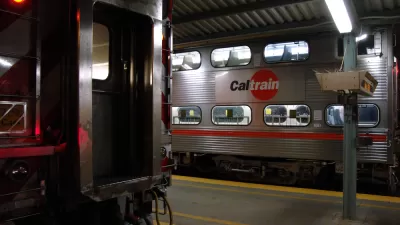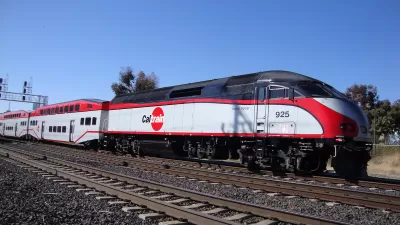The San Francisco to San Jose Caltrain commuter rail line continues to set ridership records, but capacity has not increased, much to riders' chagrin. Starting today, four train sets will add a sixth car, courtesy of Metrolink commuter rail.
"Average weekday Caltrain ridership is at an all-time high at 58,245 passengers, a 71 percent increase since 2010 when it was at 34,120, according to initial findings of an annual ridership count presented to the Board of Directors Thursday," reports The (San Mateo) Daily Journal.
Credit: Caltrain. Note the two different liveries on the Bombardier bi-level coach cars; the first one is Metrolink's.
As with most commuter rail lines (by definition), "(m)ost riders continue to travel during peak commute hours, with a 13.1 percent increase or 3,376 from last year to this year," they add. And that has created the "standing room only" condition on many of its express and limited-stop trains during peak hours. Unlike heavy rail (subways), light rail and buses that are designed for standees, many commuter rail passenger cars, including most of Caltrains', lack that feature.
All trains currently consist of five passenger cars pulled or pushed (depending upon which direction the train is going) by a diesel-electric locomotive. Management asserts it is unable to add cars to the train consists due to a shortage of cars and high labor costs.
To add to its capacity, the Caltrain Joint Powers Board (note the 'JPB' in livery above) purchased 16 "very used" (as CBS SF makes clear) Bombardier bi-level coach cars from the Southern Califonia Metrolink commuter rail system last fall for $5.6 million. That's the good news.
The bad news is "(i)t will take an additional $9 million to rehabilitate the cars and perform work at some platforms along the corridor to accommodate the planned longer trains," according to Caltrain Connection [PDF]. Rehabilitation of some cars could take as long as a year, they note.
The Metrolink cars are compatible with Caltrains' newest cars, the so-called 'baby bullet' Bombardier train sets [also see in 'related' below]. Most of the rolling stock are Nippon Sharyo gallery cars [see YouTube] that appear very similar to Chicago Metra cars.
Fortunately for Caltrain commuters, four of the refurbished cars go into service on Monday (May 11), added to existing five-car baby bullet trains.
"The sixth car will provide an additional 150 seats and increase standing room during the peak-hour commute, according to Caltrain," writes the Daily Journal. The sixth car will be added to the indicated train numbers.
According to Streetsblog's Andrew Boone, the refurbished Bombardier cars may also accommodate bicycles:

Caltrain’s Bombardier trains currently only carry 48 bikes each. With trains receiving a third bike car, 72 bikes can fit on board. Photo: John Woodell/Twitter
While crowding has created unpleasant traveling conditions, it has also added greatly to farebox revenue, which is paying for the Metrolink car acquisition through "a 2015 farebox revenue bond issuance," according to Caltrain Connection.
[For more on Caltrain revenue, see Green Caltrain: "Caltrain balances 2016 budget with rider revenues"].
Due to its high ridership and short route, only 77 miles serving San Francisco, San Mateo and Santa Clara counties, the train line has the third highest "ridership per mile" [average daily ridership divided by route miles] among commuter rail lines according to Wikipedia, behind only LIRR and Metro-North.
The addition of the Metrolink cars are a stopgap measure to reduce crowding while Caltrain is working on its $1.7 billion modernization program to electrify the line between San Jose and San Francisco and implement a Positive Train Control safety system. "The Project is scheduled to be complete in 2020," according to Caltrain.
FULL STORY: Caltrain ridership hits all-time high — again

Alabama: Trump Terminates Settlements for Black Communities Harmed By Raw Sewage
Trump deemed the landmark civil rights agreement “illegal DEI and environmental justice policy.”

Study: Maui’s Plan to Convert Vacation Rentals to Long-Term Housing Could Cause Nearly $1 Billion Economic Loss
The plan would reduce visitor accommodation by 25% resulting in 1,900 jobs lost.

Planetizen Federal Action Tracker
A weekly monitor of how Trump’s orders and actions are impacting planners and planning in America.

Wind Energy on the Rise Despite Federal Policy Reversal
The Trump administration is revoking federal support for renewable energy, but demand for new projects continues unabated.

Passengers Flock to Caltrain After Electrification
The new electric trains are running faster and more reliably, leading to strong ridership growth on the Bay Area rail system.

Texas Churches Rally Behind ‘Yes in God’s Back Yard’ Legislation
Religious leaders want the state to reduce zoning regulations to streamline leasing church-owned land to housing developers.
Urban Design for Planners 1: Software Tools
This six-course series explores essential urban design concepts using open source software and equips planners with the tools they need to participate fully in the urban design process.
Planning for Universal Design
Learn the tools for implementing Universal Design in planning regulations.
Caltrans
Smith Gee Studio
Institute for Housing and Urban Development Studies (IHS)
City of Grandview
Harvard GSD Executive Education
Toledo-Lucas County Plan Commissions
Salt Lake City
NYU Wagner Graduate School of Public Service





























